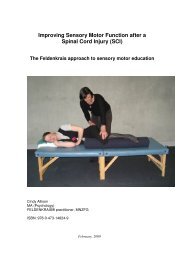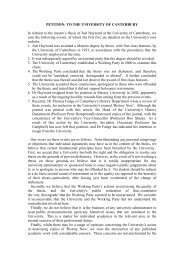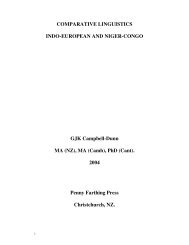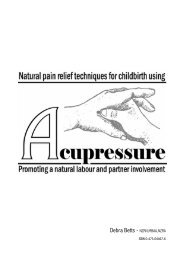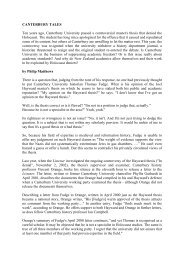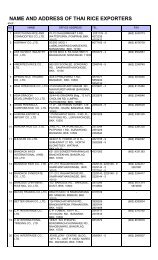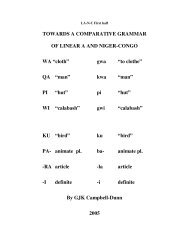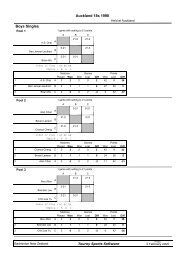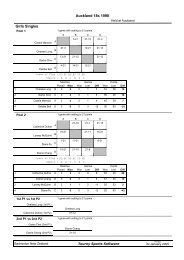Wairua and the relationship it has with learning te reo ... - Clear Net
Wairua and the relationship it has with learning te reo ... - Clear Net
Wairua and the relationship it has with learning te reo ... - Clear Net
Create successful ePaper yourself
Turn your PDF publications into a flip-book with our unique Google optimized e-Paper software.
Methodological approach:<br />
Ethnography as a research method is used by some educationalists to<br />
“describe how individuals in a group in<strong>te</strong>rpret <strong>the</strong>ir worlds” (LeComp<strong>te</strong> &<br />
Schensul 1999:97). By employing qual<strong>it</strong>ative ethnographic <strong>te</strong>chniques for<br />
data collection <strong>and</strong> data analysis some <strong>te</strong>ntative conclusions may be<br />
arrived at. As this is largely an unexplored area of inquiry I hope this<br />
research will act as a basis for future investigations. Māori, Indigenous,<br />
<strong>and</strong> Wes<strong>te</strong>rn 5 epis<strong>te</strong>mologies have been used to guide <strong>and</strong> genera<strong>te</strong><br />
in<strong>te</strong>rpretive discussion <strong>and</strong> <strong>the</strong>ory arising from this work, allowing<br />
movement through <strong>and</strong> beyond a pos<strong>it</strong>ion of cr<strong>it</strong>ical “oppos<strong>it</strong>ional<br />
pos<strong>it</strong>ioning” (Mered<strong>it</strong>h 1999:13).<br />
According to LeComp<strong>te</strong> <strong>and</strong> Schensul a compressed ethnographic<br />
study is justified when <strong>the</strong> ethnographer is loca<strong>te</strong>d in <strong>and</strong> “familiar w<strong>it</strong>h <strong>the</strong><br />
field setting, cultural con<strong>te</strong>xt, <strong>and</strong> language”. Secondly, “<strong>the</strong> work must be<br />
focused on one aspect of <strong>the</strong> culture”. Thirdly, “ethnographers should work<br />
w<strong>it</strong>h cultural experts from <strong>the</strong> setting”. Thereby “speeding <strong>the</strong> work,<br />
ensuring valid<strong>it</strong>y”, aiding in “establishing <strong>the</strong> con<strong>te</strong>xt for <strong>the</strong> data<br />
collection”, <strong>and</strong> improving modifications in “design <strong>and</strong> in<strong>te</strong>rpretation of <strong>the</strong><br />
results” (LeComp<strong>te</strong> & Schensul 1999:88,89). Insider bias was addressed<br />
through “disciplined reflexiv<strong>it</strong>y, sys<strong>te</strong>matic documentation <strong>and</strong> analysis,<br />
<strong>and</strong> multi-face<strong>te</strong>d qual<strong>it</strong>ative methods” (McCarty 1997:234). The<br />
circumstances of this study f<strong>it</strong> <strong>the</strong> above specifications outlined by<br />
LeComp<strong>te</strong>, Schensul <strong>and</strong> McCarty in that <strong>the</strong> researcher is a past student<br />
<strong>and</strong> member of <strong>the</strong> Te Ataarangi Incorpora<strong>te</strong>d Society. Only one aspect of<br />
second language acquis<strong>it</strong>ion was explored <strong>and</strong> that was wairua. Data was<br />
ga<strong>the</strong>red from a variety of sources, in<strong>te</strong>rviews were documen<strong>te</strong>d w<strong>it</strong>hin a<br />
compu<strong>te</strong>r software package to manage retrieval of data for analysis.<br />
In<strong>te</strong>rpretations <strong>and</strong> quo<strong>te</strong>s were checked by participants, as this research<br />
report is based upon <strong>the</strong> combined experiences of <strong>the</strong> in<strong>te</strong>rviewees.<br />
5<br />
Wes<strong>te</strong>rn is being defined as essentially privileging rational<strong>it</strong>y over o<strong>the</strong>r forms of knowing<br />
(Sm<strong>it</strong>h 1999). Some Wes<strong>te</strong>rn scholars recognise that <strong>the</strong>re are o<strong>the</strong>r forms of knowledge<br />
such as inwardness (Berns<strong>te</strong>in 1996) which have <strong>the</strong> capac<strong>it</strong>y to transform (Wexler 2002) <strong>and</strong><br />
are equally valid.<br />
11



